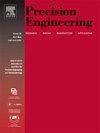Investigation on plastic and brittle characteristic of magnesium aluminum spinel in ultra-precision grinding
IF 3.5
2区 工程技术
Q2 ENGINEERING, MANUFACTURING
Precision Engineering-Journal of the International Societies for Precision Engineering and Nanotechnology
Pub Date : 2025-03-04
DOI:10.1016/j.precisioneng.2025.03.001
引用次数: 0
Abstract
Magnesium aluminate spinel is utilized in aerospace, optics, and electronics due to its optical properties, strength, thermal stability, and corrosion resistance. Ultra-precision grinding delivers superior surface finishing, optimal for hard and brittle substances. Surface quality after ultra-precision grinding affects optical performance significantly. In this paper, the material removal mechanism of magnesium aluminate spinel is investigated. A comprehensive method for evaluating the three-dimensional surface after ultra-precision grinding is proposed, which clearly describes the distribution of surface states. Surface error indicators are suggested for the plasticity and brittleness domain of ground surfaces. Additionally, three-dimensional surface analysis of magnesium aluminate spinel after ultra-precision grinding is performed utilizing Fourier transform. The optimized ultra-precision grinding process parameters by the firefly algorithm are obtained as ns = 20200 r·min−1, vw = 1.2 mm min−1, ap = 1.5 μm. The mid-frequency surface roughness is 0.015 μm, and the profile height is 0.23 μm. This research achieves an optimal balance between grinding efficiency and surface quality, offering guidelines for the grinding processes for other brittle and hard materials.
镁铝尖晶石超精密磨削塑性脆性特性研究
铝酸镁尖晶石因其光学性能、强度、热稳定性和耐腐蚀性而被应用于航空航天、光学和电子领域。超精密磨削提供卓越的表面光洁度,最适合硬和脆的物质。超精密磨削后的表面质量对光学性能有显著影响。本文研究了铝酸镁尖晶石的材料去除机理。提出了一种综合评价超精密磨削后三维表面状态的方法,该方法清晰地描述了表面状态的分布。提出了地表塑性和脆性域的表面误差指标。此外,利用傅里叶变换对铝酸镁尖晶石超精密磨削后的三维表面进行了分析。采用萤火虫算法优化得到的超精密磨削工艺参数为:ns = 20200 r·min - 1, vw = 1.2 mm min - 1, ap = 1.5 μm。中频表面粗糙度为0.015 μm,轮廓高度为0.23 μm。该研究实现了磨削效率和表面质量的最佳平衡,为其他脆硬材料的磨削工艺提供了指导。
本文章由计算机程序翻译,如有差异,请以英文原文为准。
求助全文
约1分钟内获得全文
求助全文
来源期刊
CiteScore
7.40
自引率
5.60%
发文量
177
审稿时长
46 days
期刊介绍:
Precision Engineering - Journal of the International Societies for Precision Engineering and Nanotechnology is devoted to the multidisciplinary study and practice of high accuracy engineering, metrology, and manufacturing. The journal takes an integrated approach to all subjects related to research, design, manufacture, performance validation, and application of high precision machines, instruments, and components, including fundamental and applied research and development in manufacturing processes, fabrication technology, and advanced measurement science. The scope includes precision-engineered systems and supporting metrology over the full range of length scales, from atom-based nanotechnology and advanced lithographic technology to large-scale systems, including optical and radio telescopes and macrometrology.

 求助内容:
求助内容: 应助结果提醒方式:
应助结果提醒方式:


